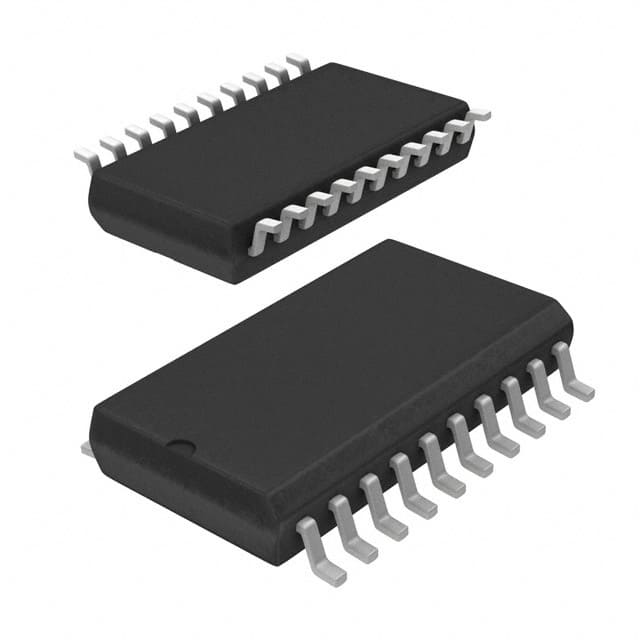Xem thông số kỹ thuật để biết chi tiết sản phẩm.

74LVC245AMTR
Basic Information Overview
- Category: Integrated Circuit (IC)
- Use: Level Shifter and Bus Transceiver
- Characteristics: Low Voltage CMOS, Octal Bus Transceiver with 3-State Outputs
- Package: TSSOP (Thin Shrink Small Outline Package)
- Essence: This IC is designed to shift logic levels and provide bidirectional voltage translation between different voltage domains. It can be used in various applications where interfacing between different voltage levels is required.
- Packaging/Quantity: The 74LVC245AMTR is typically available in reels of 2500 units.
Specifications
- Supply Voltage Range: 1.65V to 5.5V
- High-Level Input Voltage: 0.7 x VCC to VCC + 0.3V
- Low-Level Input Voltage: -0.3V to 0.3V
- High-Level Output Voltage: 0.9 x VCC to VCC
- Low-Level Output Voltage: 0V to 0.1 x VCC
- Maximum Operating Frequency: 80 MHz
- Number of Channels: 8
- Output Drive Capability: ±24 mA
- Propagation Delay: 4 ns (Max)
Detailed Pin Configuration
The 74LVC245AMTR has a total of 20 pins, which are assigned as follows:
- Pin 1: OE (Output Enable)
- Pin 2: A1 (Input/Output)
- Pin 3: B1 (Input/Output)
- Pin 4: A2 (Input/Output)
- Pin 5: B2 (Input/Output)
- Pin 6: A3 (Input/Output)
- Pin 7: B3 (Input/Output)
- Pin 8: A4 (Input/Output)
- Pin 9: B4 (Input/Output)
- Pin 10: GND (Ground)
- Pin 11: B5 (Input/Output)
- Pin 12: A5 (Input/Output)
- Pin 13: B6 (Input/Output)
- Pin 14: A6 (Input/Output)
- Pin 15: B7 (Input/Output)
- Pin 16: A7 (Input/Output)
- Pin 17: B8 (Input/Output)
- Pin 18: A8 (Input/Output)
- Pin 19: VCC (Supply Voltage)
- Pin 20: DIR (Direction Control)
Functional Features
- Bidirectional voltage translation between different voltage domains.
- 3-state outputs allow multiple devices to share a common bus.
- Low power consumption and wide supply voltage range make it suitable for battery-powered applications.
- Schmitt-trigger inputs provide hysteresis, improving noise immunity.
Advantages
- Provides seamless interfacing between different voltage levels.
- High-speed operation allows for efficient data transfer.
- 3-state outputs enable easy bus sharing among multiple devices.
- Wide supply voltage range enhances versatility in various applications.
- Schmitt-trigger inputs improve noise immunity.
Disadvantages
- May not be suitable for high-power applications due to limited output drive capability.
- Requires careful consideration of voltage level compatibility to avoid damage or incorrect operation.
Working Principles
The 74LVC245AMTR operates by using a combination of CMOS technology and level shifting techniques. It consists of eight bidirectional buffers with 3-state outputs, allowing bidirectional voltage translation between two voltage domains. The direction of data flow is controlled by the DIR pin. When the DIR pin is set to a logic high, data flows from the A side to the B side, and when it is set to a logic low, data flows from the B side to the A side.
Detailed Application Field Plans
The 74LVC245AMTR can be used in various applications where interfacing between different voltage levels is required. Some common application fields include: - Microcontroller and peripheral communication. - Level shifting in mixed-voltage systems. - Interface between different logic families (e.g., TTL and CMOS). - Data bus buffering and translation. - Voltage level conversion in battery-powered devices.
Detailed and Complete Alternative Models
Some alternative models that provide similar functionality to the 74LVC245AMTR are: - SN74LVC245A by Texas Instruments - MC74LVX245 by ON Semiconductor - CD74HCT245 by Texas Instruments - 74HC245 by NXP Semiconductors
These alternative models offer comparable features and can be considered as replacements based on specific requirements and availability.
In conclusion, the 74LVC245AMTR is a versatile integrated circuit that enables bidirectional voltage translation between different voltage domains. Its low power consumption, wide supply voltage range, and 3-state outputs make it suitable for various applications requiring
Liệt kê 10 câu hỏi và câu trả lời thường gặp liên quan đến ứng dụng 74LVC245AMTR trong giải pháp kỹ thuật
Sure! Here are 10 common questions and answers related to the application of 74LVC245AMTR in technical solutions:
Q: What is the purpose of the 74LVC245AMTR? A: The 74LVC245AMTR is an octal bus transceiver that can be used to enable bidirectional level shifting between two voltage domains.
Q: What is the operating voltage range of the 74LVC245AMTR? A: The 74LVC245AMTR operates within a voltage range of 1.65V to 5.5V.
Q: How many data lines can the 74LVC245AMTR handle? A: The 74LVC245AMTR can handle 8 data lines, as it is an octal (8-bit) bus transceiver.
Q: Can the 74LVC245AMTR be used for level shifting between different voltage levels? A: Yes, the 74LVC245AMTR can be used to shift logic levels between different voltage domains, making it suitable for interfacing between devices with different voltage requirements.
Q: Does the 74LVC245AMTR support bi-directional communication? A: Yes, the 74LVC245AMTR supports bidirectional data transfer, allowing data to flow in both directions.
Q: What is the maximum data transfer rate supported by the 74LVC245AMTR? A: The 74LVC245AMTR can support data transfer rates up to 400 Mbps.
Q: Can the 74LVC245AMTR be used in applications requiring hot-swapping capability? A: Yes, the 74LVC245AMTR has built-in protection features that allow for hot-swapping of devices without causing damage.
Q: What is the power supply voltage required for the 74LVC245AMTR? A: The 74LVC245AMTR requires a power supply voltage between 1.65V and 5.5V.
Q: Can the 74LVC245AMTR be used in both 3.3V and 5V systems? A: Yes, the 74LVC245AMTR is compatible with both 3.3V and 5V systems, making it versatile for various applications.
Q: Are there any special considerations when using the 74LVC245AMTR in high-speed applications? A: Yes, in high-speed applications, it is important to ensure proper signal integrity by following recommended PCB layout guidelines and minimizing trace lengths.

